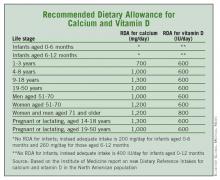WASHINGTON – Daily doses of 600 international units of vitamin D and between 700 and 1,300 mg of calcium are enough for most children and adults in the United States and Canada, according to a report on new dietary reference intakes issued by the Institute of Medicine.
These new dietary reference intakes for calcium and vitamin D should provide "greater assurance that widespread vitamin D deficiency is not a public health problem," Dr. Steven Clinton, a member of the IOM committee that issued the report. Committee members spoke at a Nov. 30 press briefing.
After reviewing national databases on blood levels from the United States and Canada, the committee determined that most people in both countries are currently meeting their needs for vitamin D. Adequate vitamin D was defined as blood levels of at least 20 ng/mL as measured in the United States (50 nmol/L as measured in Canada).
Dr. Clinton, a medical oncologist at Ohio State University, Columbus, predicted that physicians will become more comfortable using recommended dietary allowances to advise patients about calcium and vitamin D intake and noted that vitamin D screening "probably should not be part of routine medical care."
Previous recommendations for vitamin D and calcium intake were defined in terms of adequate intake, which is not the same as recommended dietary allowance (RDA), noted committee member Patsy Brannon, Ph.D., a professor in the division of nutritional science at Cornell University, Ithaca, N.Y. Although the new values might not look much different, "You can't compare the two sets of numbers," she said. The evidence used to determine the new RDAs for calcium and vitamin D was much more comprehensive, especially data from studies conducted within the past 2 years, she explained.
While calcium and vitamin D are important for health, more is not necessarily better, the reviewers said.
They cautioned against excessive vitamin D supplementation beyond the RDA, but said supplements can be used in combination with diet to meet the RDAs. "The data are not sufficient to conclude that intakes higher than the recommended values would be beneficial," A. Catherine Ross, Ph.D., of Pennsylvania State University, University Park.
To reduce the risk of kidney stones, calcium supplements should be used with caution, Dr. Brannon advised.
The IOM reviewers examined approximately 1,000 published studies and scientific testimonies to determine the levels of calcium and vitamin D needed to maintain health.
Based on their findings, 700 mg/day of calcium is enough for most children aged 1-3 years, and 1,000 mg is appropriate for most children aged 4-8 years. Older children and teens aged 9-18 years need no more than 1,300 mg/day, and most adults aged 19-50 years and men through 71 years need no more than 1,000 mg daily. For women aged 51 years and older and men aged 71 years and older, 1,200 mg of calcium per day is recommended, but more than that is unnecessary, according to the report.
As for vitamin D, the IOM report states that 600 IU/day meets the needs of almost all children and adults aged 1 year through 70 years, including pregnant and lactating women. For men and women aged 71 years and older, the RDA increases to 800 IU/day to accommodate age-related physical and behavioral changes.
The IOM review committee acknowledged the challenges of fitting sun exposure into the equation when estimating dietary reference intake values for vitamin D because of concerns about skin cancer risk. "At this time, the only solution is to proceed on the basis of the assumption of minimal sun exposure and set reference values assuming that all of the vitamin D comes from the diet," the reviewers wrote.
The report lists an upper level for daily vitamin D intake of 1,000 IU for infants up to 6 months of age and 1,500 IU for infants aged 6 months to 12 months. The upper levels for children aged 1-3 years and 4-8 years are 2,500 IU and 3,000 IU, respectively. For all other life stages, the upper level is 4,000 IU.
Upper levels for calcium for adults were based on data related to the formation of kidney stones, and the upper levels for children take adolescent growth spurts into account. The upper level for daily calcium intake for infants aged 0 to 6 months and 6-12 months are 1,000 mg and 1,500 mg, respectively. For children aged 1-8 years and 9-18 years, the upper levels are 2,500 mg and 3,000 mg, respectively, for both boys and girls. Adults aged 19-50 years have an upper level of 2,500 mg that drops to 2,000 mg after age 50 years for both men and women. The upper levels of calcium for pregnant and lactating women aged 14-18 years, 19-30 years, and 31-50 years are 3,000 mg, 2,500 mg, and 2,500 mg, respectively.

